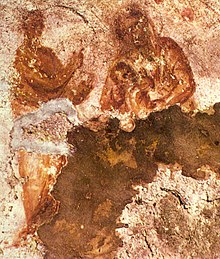Catacomb of Priscilla
 Possibly an image of Mary nursing the Infant Jesus. 3rd century, Catacomb of Priscilla | |
 Click on the map to see marker. | |
| Location | Rome, Italy |
|---|---|
| Coordinates | 41°55′47″N 12°30′31″E / 41.9297°N 12.5087°E |
| Type | Catacombs |
The Catacomb of Priscilla is an archaeological site on the
The modern entrance to the catacomb is on the Via Salaria through the cloister of the monastery of the Benedictines of Priscilla. The Catacombs of Priscilla are divided into three principal areas: an arenarium, a cryptoporticus from a large Roman villa, and the underground burial area of the ancient Roman family, the Acilius Glabrio.
Artworks
The wall paintings in this catacomb include images of saints and early
| External videos | |
|---|---|
 | |
Particularly notable is the "Greek Chapel" (Capella Greca), a square chamber with an arch which contains 3rd century
The Priscilla catacombs may contain the oldest known Marian paintings, from the early third century.[4][5] Mary is shown with Jesus on her lap, and the catacombs may have a depiction of the Annunciation, though the latter has been disputed.[6]
Papal tombs
On account of the fact that seven early
Alleged relics of Popes
Other relics
The bones of Saints Praxedes and Pudentiana were contained in the catacomb until they were moved in the 9th century by Pope Paschal I to be housed in the rebuilt Santa Prassede.[9]
It is also in this catacomb that the relics of saint Philomena were found.
References
- ISBN 9781406866100
- ^ "Catacomb of Priscilla, Rome". Smarthistory at Khan Academy. Retrieved October 10, 2014.
- ^ Nicola Denzey, The Bone Gatherers: The Lost Worlds of Early Christian Women, Boston: Beacon Press 2007
- ^ La prima immagine di Maria nelle catacombe di Priscilla (Roma) [The first image of the Virgin Mary in the catacomb of Priscilla] (in Italian). TV2000. Archived from the original on 2021-12-14. Retrieved March 28, 2021.
- ^ Pontificia Academia Cultorum Martyrum. Archived(PDF) from the original on January 17, 2010.
- ISBN 978-0-913836-99-6p. 173; compare Mary Joan Winn Leith, "Earliest Depictions of the Virgin Mary," Biblical Archaeology Review, vol. 43, no. 2, March/April 2017, p. 49
- ^ Reardon, 2004, p. 32.
- ^ Reardon, 2004, pp. 33–34.
- ^ "Praxedes and Pudentia". Catholic Encyclopedia. Retrieved 26 October 2010.
Sources
- Reardon, Wendy J. 2004. The Deaths of the Popes. Macfarland & Company, Inc. ISBN 0-7864-1527-4
